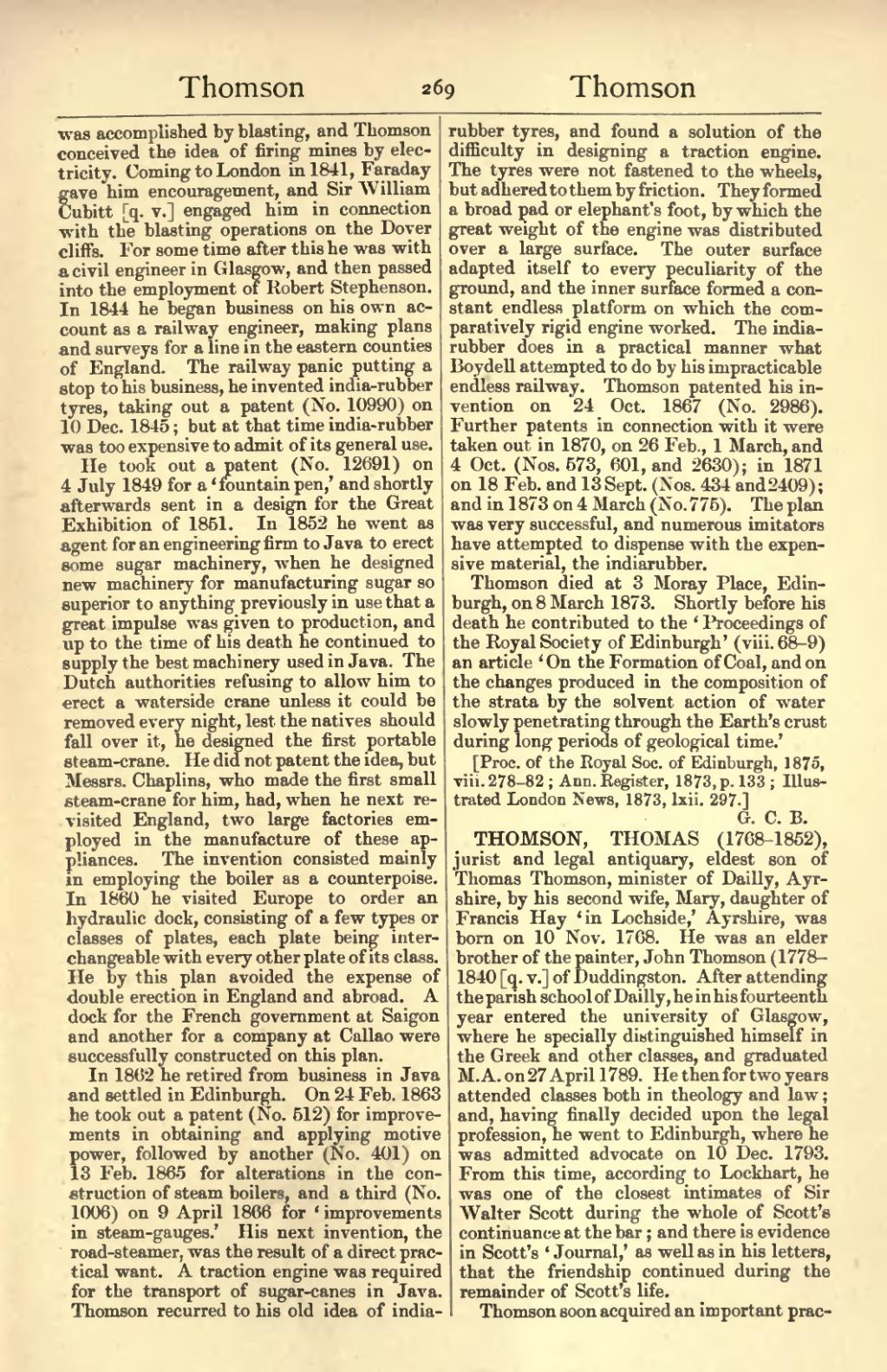was accomplished by blasting, and Thomson conceived the idea of firing mines by electricity. Coming to London in 1841, Faraday gave him encouragement, and Sir William Cubitt [q. v.] engaged him in connection with the blasting operations on the Dover cliffs. For some time after this he was with a civil engineer in Glasgow, and then passed into the employment of Robert Stephenson. In 1844 he began business on his own account as a railway engineer, making plans and surveys for a line in the eastern counties of England. The railway panic putting a stop to his business, he invented india-rubber tyres, taking out a patent (No. 10990) on 10 Dec. 1845; but at that time india-rubber was too expensive to admit of its general use.
He took out a patent (No. 12691) on 4 July 1849 for a ‘fountain pen,’ and shortly afterwards sent in a design for the Great Exhibition of 1851. In 1852 he went as agent for an engineering firm to Java to erect some sugar machinery, when he designed new machinery for manufacturing sugar so superior to anything previously in use that a great impulse was given to production, and up to the time of his death he continued to supply the best machinery used in Java. The Dutch authorities refusing to allow him to erect a waterside crane unless it could be removed every night, lest the natives should fall over it, he designed the first portable steam-crane. He did not patent the idea, but Messrs. Chaplins, who made the first small steam-crane for him, had, when he next revisited England, two large factories employed in the manufacture of these appliances. The invention consisted mainly in employing the boiler as a counterpoise. In 1860 he visited Europe to order an hydraulic dock, consisting of a few types or classes of plates, each plate being interchangeable with every other plate of its class. He by this plan avoided the expense of double erection in England and abroad. A dock for the French government at Saigon and another for a company at Callao were successfully constructed on this plan.
In 1862 he retired from business in Java and settled in Edinburgh. On 24 Feb. 1863 he took out a patent (No. 512) for improvements in obtaining and applying motive power, followed by another (No. 401) on 13 Feb. 1865 for alterations in the construction of steam boilers, and a third (No. 1006) on 9 April 1866 for ‘improvements in steam-gauges.’ His next invention, the road-steamer, was the result of a direct practical want. A traction engine was required for the transport of sugar-canes in Java. Thomson recurred to his old idea of india-rubber tyres, and found a solution of the difficulty in designing a traction engine. The tyres were not fastened to the wheels, but adhered to them by friction. They formed a broad pad or elephant's foot, by which the great weight of the engine was distributed over a large surface. The outer surface adapted itself to every peculiarity of the ground, and the inner surface formed a constant endless platform on which the comparatively rigid engine worked. The india-rubber does in a practical manner what Boydell attempted to do by his impracticable endless railway. Thomson patented his invention on 24 Oct. 1867 (No. 2986). Further patents in connection with it were taken out in 1870, on 26 Feb., 1 March, and 4 Oct. (Nos. 573, 601, and 2630); in 1871 on 18 Feb. and 13 Sept. (Nos. 434 and 2409); and in 1873 on 4 March (No. 775). The plan was very successful, and numerous imitators have attempted to dispense with the expensive material, the india-rubber.
Thomson died at 3 Moray Place, Edinburgh, on 8 March 1873. Shortly before his death he contributed to the ‘Proceedings of the Royal Society of Edinburgh’ (viii. 68–9) an article ‘On the Formation of Coal, and on the changes produced in the composition of the strata by the solvent action of water slowly penetrating through the Earth's crust during long periods of geological time.’
[Proc. of the Royal Soc. of Edinburgh, 1875, viii. 278–82; Ann. Register, 1873, p. 133; Illustrated London News, 1873, lxii. 297.]
THOMSON, THOMAS (1768–1852), jurist and legal antiquary, eldest son of Thomas Thomson, minister of Dailly, Ayrshire, by his second wife, Mary, daughter of Francis Hay ‘in Lochside,’ Ayrshire, was born on 10 Nov. 1768. He was an elder brother of the painter, John Thomson (1778–1840) [q. v.] of Duddingston. After attending the parish school of Dailly, he in his fourteenth year entered the university of Glasgow, where he specially distinguished himself in the Greek and other classes, and graduated M.A. on 27 April 1789. He then for two years attended classes both in theology and law; and, having finally decided upon the legal profession, he went to Edinburgh, where he was admitted advocate on 10 Dec. 1793. From this time, according to Lockhart, he was one of the closest intimates of Sir Walter Scott during the whole of Scott's continuance at the bar; and there is evidence in Scott's ‘Journal,’ as well as in his letters, that the friendship continued during the remainder of Scott's life.
Thomson soon acquired an important prac-
